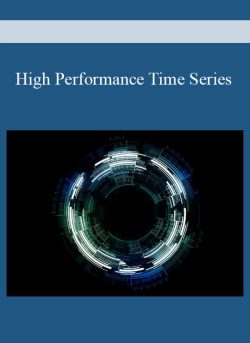High Performance Time SeriesHigh Performance Time SeriesBecome the time-series domain expert for your organizationBecome the Time Series Expert for your organizationThe High-Performance Time Series Forecasting Course is an amazing course designed to teach Business Analysts and Data Scientists how to reduce forecast error using state-of-the-art forecasting techniques that have won competitions. You’ll undergo a complete transformation learning the most in-demand skills that organizations need right now. Time to accelerate your career.Crafted For Business Analysts & Data ScientistsThat need to reduce forecasting error and scale results for your organization.This is possibly my most challenging course ever. You’ll learn the time series skills that have taken me 10-years of study, practice, and experimentation.My talk on High-Performance Time Series ForecastingThis course gives you the tools you need to meet today’s forecasting demands.A full year was spent on building two of the software packages you’ll learn,modeltimeandtimetk.Plus, I’m teaching youGluonTS, a state-of-the-art deep learning framework for time series written in python.This course will challenge you. It will change you. It did me.– Matt Dancho, Course Instructor & Founder of Business ScienceUndergo a Complete TransformationBy learning forecasting techniques that get resultsWith High-Performance Forecasting, you will undergo a complete transformation by learning the most in-demand skills for creating high-accuracy forecasts.Through this course, you will learn and apply:Machine Learning & Deep LearningFeature EngineeringVisualization & Data WranglingTransformationsHyper Parameter TuningForecasting at Scale (Time Series Groups)How it worksYour path to becoming an Expert Forecaster is simplified into 3 streamlined steps.1Time Series Feature Engineering2Machine Learning for Time Series3Deep Learning for Time SeriesPart 1Time Series Feature EngineeringFirst, we build your time series feature engineering skills. You learn:Visualization: Identifying features visually using the most effective plotting techniquesData Wrangling: Aggregating, padding, cleaning, and extending time series dataTransformations: Rolling, Lagging, Differencing, Creating Fourier Series, and moreFeature Engineering: Over 3-hours of content on introductory and advanced feature engineeringPart 2Machine Learning for Time SeriesNext, we build your time series machine learning skills. You learn:17 Algorithms: 8 hours of content on 17 TOP Algorithms. Divided into 5 groups:ARIMAProphetExponential Smoothing – ETS, TBATS, Seasonal DecompositionMachine Learning – Elastic Net, MARS, SVM, KNN, Random Forest, XGBOOST, Cubist, NNET & NNETARBoosted Algorithms – Prophet Boost & ARIMA BoostHyper Parameter Tuning: Strategies to reduce overfitting & increase model performanceTime Series Groups: Scale your analysis from one time series to hundredsParallel Processing: Needed to speed up hyper parameter tuning and forecasting at scaleEnsembling: Combining many algorithms into a single super learnerPart 3Deep Learning for Time SeriesNext, we build your time series deep learning skills. You learn:GluonTS: A state-of-the-art forecasting package that’s built on top of mxnet (made by Amazon)Algorithms: Learn DeepAR, DeepVAR, NBEATS, and more!Challenges & Cheat SheetsNext, we build your time series machine learning skills. You learn:Cheat Sheets: Developed to make your forecasting workflow reproducible on any problemChallenges: Designed to test your abilities & solidify your knowledgeSummary of what you getA methodical training plan that goes from concept to production ($10,000 value)Part 1 – Feature Engineering with TimetkPart 2 – Machine Learning with ModeltimePart 3 – Deep Learning with GluonTSChallenges & Cheat SheetsYour InstructorMatt DanchoFounder of Business Science and general business & finance guru, He has worked with many clients from Fortune 500 to high-octane startups! Matt loves educating data scientists on how to apply powerful tools within their organization to yield ROI. Matt doesn’t rest until he gets results (literally, he doesn’t sleep so don’t be suprised if he responds to your email at 4AM)!Course CurriculumWelcome to High Performance Time Series!High-Performance Time Series – Become the Time Series Expert for Your Organization (2:34)Private Slack Channel – How to JoinVideo Subtitles (Captions)What is a High-Performance Forecasting System?[IMPORTANT] System Requirements – R + Python Requirements & Common IssuesPrerequisitesPrerequisite – Data Science for Business Part 1Getting HelpGetting Help (IMPORTANT!!!)Module 0 – Introduction to High-Performance ForecastingHigh-Performance Forecasting – What You’re Learning, Why You’re Learning It (0:43)0.1 Forecast Competition ReviewThe Forecasting Competition Review & Course Progression (3:34)2014 Kaggle Walmart Recruiting Challenge (5:11)2018 M4 Competition (3:37)2018 Kaggle Wikipedia Website Traffic Forecasting Competition (4:30)2020 M5 Competition (5:59)5 Key Takeaways from the Forecast Competition Review (5:41)0.2 Course Projects – Google Analytics, Email Subscribers, & Sales ForecastingThe Business Case – Developing a Best-in-Class Forecasting System (3:03)0.3 What Tools are in Your Toolbox?Timetk: Time Series Data Preparation, Visualization, & Preprocessing (5:54)Modeltime: Time Series Machine Learning (5:25)GluonTS: Time Series Deep Learning (2:01)?️ [Cheat Sheet] Forecasting WorkflowModule 01 – Time Series JumpTime Series Jump (0:54)1.1 Time Series Project SetupProject Setup (2:28)Course Data (File Download) (1:02)R Package Installation – Part 1 (File Download) (5:26)R Package Installation – Part 2 (5:14)Jump Setup (File Download) (0:44)1.2 Business Understanding & Dataset TerminologyEstablish Relationships, Part 1 – Google Analytics Summary Dataset (4:11)Establish Relationships, Part 2 – Google Analytics Top 20 Pages (5:23)Build Relationships – Mailchimp & Learning Lab Events (4:49)Generate Course Revenue – Transaction Revenue & Product Events (3:03)Code Checkpoint (File Download) (0:54)1.3 TS Jump: Dive into Forecasting Email Subscribers!Read This! – Time Series Jump IntentTime Series Jump – Setup (File Download) (3:20)Libraries & Data (3:13)1.3.1 Exploratory Data Analysis for Time SeriesEDA for Time Series (1:08)Summarize By Time (5:46)Time Series Summary Diagnostics (4:47)Pad by Time (4:08)Visualize the Time Series (3:12)1.3.2 Evaluation & Train/Test WindowsEvaluation Window – Filter By Time (4:43)Time Series Train/Test Split (4:53)1.3.3 Forecasting with ProphetTraining a Prophet Model with Modeltime (4:21)Modeltime Forecasting Workflow – Round 1 (7:43)1.3.4 Forecasting with Feature EngineeringVisualizing Seasonality (4:34)Feature Engineering – Part 1 (5:45)Feature Engineering – Part 2 (5:51)Machine Learning with Workflows (3:35)Modeltime Forecasting Workflow – Round 2 (5:59)1.3.5 Recap & Code Checkpoint – Module 01 – TS JumpHere’s where you are going. (3:11)Code Checkpoint (File Download)✨[Part 1] Time Series with TimetkWelcome to Part 1 – Time Series with Timetk! (2:17)Module 02 – Time Series VisualizationSetup (File Download) & Overview – Visualization (2:11)Data Preparation – Part 1 (4:29)Data Preparation – Part 2 (3:23)2.1 Time Series Plots [MUST KNOW FUNCTION] ?[MUST KNOW] Plotting Time Series ? (5:31)Plotting with Transformations (4:37)Adjusting the Smoother (6:11)Smoother for Groups (1:54)Interactive & Static Plots (2:00)2.2 Autocorrelation PlotsACF & PACF Concepts – Autocorrelation & Partial AutocorrelationACF & PACF Plotting (7:49)Lag Adjustment (1:24)CCF Plotting – Cross Correlations (7:58)2.3 Seasonality PlotsSeasonality Box Plot (5:52)Seasonality Violin Plot (0:53)2.4 Anomaly PlotsAnomaly Plot Basics (4:50)Getting the Anomaly Data (2:00)Working with Grouped Data (1:43)2.5 STL Decomposition & Regression PlotsSTL Decomposition Plot (4:44)STL Decomposition – Grouped Time Series (2:11)2.6 Regression Plots [SECRET WEAPON FOR FEATURE ENGINEERING][SECRET WEAPON] Time Series Regression Plot ??? (7:08)Time Series Regression Plot – Grouped Time Series (4:05)2.7 Code Checkpoint – Module 02 – VisualizationCode Checkpoint (File Download)Module 03 – Time Series Data WranglingSetup (File Download) & Overview – Data Wrangling (2:34)3.1 Summarise By Time [MUST KNOW] ?Single & Grouped Time Series Summarizations (4:37)Using Across (to Summarize Wide-Format Tibbles by Time) (5:11)Weekly/Monthly/Quarterly/Yearly Aggregations (3:33)Floor, Ceiling, Round (5:15)3.2 Pad by TimeFilling in Gaps (2:54)From Low-Frequency to High-Frequency (3:36)3.3 Filter By TimeZooming & Slicing (5:14)Offsetting by Time (2:01)3.4 Mutate By TimeExtrapolate the Mean, Median, Max, Min By Time (7:57)3.5 Joining By TimeCombining Subscribers & Web Traffic (3:48)Inspecting the Join (3:00)Formatting the Join for Feature Relationships (5:49)Join Cross Correlations (3:22)3.6 Time Series Index OperationsMaking a Time Series (4:39)Making a Holiday Sequence (3:14)Time Offsets (3:01)Making a Future Time Series (3:12)3.7 Forecasting with Future Frames ?The Future Frame (2:47)[FORECAST SPOTLIGHT] Forecasting with the Future Frame ? (6:53)3.8 Code Checkpoint – Module 03 – Data WranglingCode Checkpoint (File Download)Module 04 – Transformations for Time SeriesSetup (File Download) & Overview – Transformations (2:15)Libraries & Data (2:12)4.1 Variance Reduction Transformations – Log & Box Cox [MUST KNOW] ?Why is Variance Reduction Important? (4:43)Log – Log (and Log1P) Transformation (4:17)Log – Assessing the Benefit of Log1P Transformation (2:51)Log – Groups & Inversion (3:43)Box Cox – What is the Box Cox Transformation? (2:34)Box Cox – Assessing the Benefit (4:04)Box Cox – Inversion (2:05)Box Cox – Managing Grouped Transformations & Inversion (8:36)4.2 Rolling & Smoothing TransformationsIntroduction to Rolling & Smoothing (1:49)Rolling Windows – What is a Moving Average? (File Download) (3:53)Rolling Windows – Moving Average & Median Applied (8:53)Loess Smoother (7:02)Rolling Correlation – Slidify, Part 1 (4:16)Rolling Correlation – Slidify, Part 2 (7:40)[BUSINESS SPOTLIGHT] The Problem with Forecasting using a Moving Average (6:43)4.3 Range Reduction TransformationsIntroduction to Normalization & Standardization (0:59)What is Normalization? [Min = 0, Max = 1] (4:50)What is Standardization? [Mean = 0, Standard Deviation = 1] (2:31)4.4 Imputation & Outlier CleaningIntroduction to Imputation & Outlier Cleaning (0:44)Imputation – Time Series NA Repair (6:40)Anomalies – Time Series Outlier Cleaning (7:22)Anomalies – When to Remove Outliers (5:21)4.5 Lags & Differencing Transformations [MUST KNOW] ?Introduction to Lags & Differencing (1:08)Lags – What is a Lag? (1:49)Lags – Lag Detection with ACF/PACF (3:54)Lags – Regression with Lags (5:06)Differencing – Growth vs Change (4:00)Differencing – Acceleration (6:22)Differencing – Comparing Multiple Time Series (4:44)Differencing – Inversion (0:57)4.6 Fourier Series [MUST KNOW] ?Introduction to the Fourier Series (7:23)Fourier Regression (4:24)4.7 Constrained Interval Forecasting [FORECAST SPOTLIGHT] ?What is the Log Interval Transformation? (5:47)Visualizing the Transformation (4:12)Transformations & Preprocessing (5:09)Modeling (6:29)Preparing Future Data (3:36)Making Predictions (1:05)Combining the Forecast Data (4:08)Estimating Confidence Intervals (8:24)Visualizing Confidence Intervals (2:10)Inverting the Log Interval Transformation (4:08)4.8 Code Checkpoint – Module 04 – TransformationsCode Checkpoint (File Download)⛰️ Challenge #1 – Exploring Transactions & Web Page TrafficChallenge #1 Discussion (File Download) (4:21)Solution – Part 1 (File Download) (7:18)Solution – Part 2: Begins at “Identify Relationships” (7:51)Module 05 – Introduction to Feature Engineering (for Time Series)Setup (File Download) & Overview – Intro to Feature Engineering (2:30)Data Prep, Part 1 – Log Standardize (5:27)Data Prep, Part 2 – Getting Ready to Clean (5:01)Data Prep, Part 3 – Targeted Cleaning with Between Time (4:18)5.1 Time-Based Features (Trend & Seasonal/Calendar) [MUST KNOW] ?The Time Series Signature (7:55)Feature Removal (3:28)Linear Trend (2:10)Non-Linear Trend – Basis Splines (4:41)Non-Linear Trend – Natural Splines (Stiffer than Basis Splines) (4:29)Seasonal Features – Weekday & Month (3:21)Seasonal Features – Combining with Trend (5:23)5.2 InteractionsInteraction Features – Spikes Every Other Wednesday (7:35)5.3 Fourier FeaturesSelecting & Adding Fourier Frequency Features (4:21)Modeling & Visualizing the Fourier Effects (2:07)5.4 Autocorrelated Lag FeaturesSelecting & Adding Lag Features (6:59)Modeling & Visualizing the Lag Effects (5:20)5.5 Special Event FeaturesPreparing Event Data for Analysis (6:34)Visualizing Events (2:57)Modeling & Visualizing Event Effects (2:08)Fixing the Spline (2:07)5.6 External Regressors (Xregs)Transforming Xregs (5:05)Joining Xregs (1:49)Examining Cross Correlations (1:53)Modeling with Xregs (3:28)Visualizing PageViews vs Optins & Modeling Lags (6:58)5.7 Recommended Model FeaturesCollecting the Recommended Model (3:44)Saving the Model Artifact (2:28)5.8 Code Checkpoint – Module 05 – Introduction to Feature EngineeringCode Checkpoint (File Download)Module 06 – Advanced Feature Engineering WorkflowForecasting Workflow [CHEAT SHEET] ?️ (3:40)Setup (File Download) & Overview – Advanced Feature Engineering (1:43)Data Preparation (4:42)6.1 Creating the “Full” Dataset – Extending & Adding Lagged Features & Events [IMPORTANT] ?The “Full” Dataset (2:50)Extending – Future Frame (3:21)Adding Lag Features (4:02)Add Lagged Rolling Features (5:03)Add Events (External Regressors) (2:57)Format Column Names (3:09)6.2 Separate into Modeling Data & Forecast DataData Prepared / Future Data Split (2:48)6.3 Separate into Training Data & Testing DataTrain / Test Split (3:55)6.4 Recipes – Feature Engineering Pipeline StepsRecipes Intro (2:41)Step – Time Series Signature Features (5:48)Step – Feature Removal (3:10)Step – Standardization (2:11)Step – One-Hot Encoding (1:55)Step – Interaction Features (2:28)Step – Fourier Series Features (2:03)6.5 Building the Spline ModelModel Spec: LM Model (1:02)Recipe Spec: Spline Features (5:59)Workflow: Spline Recipe + LM Model (2:49)6.6 Introduction to Modeltime WorkflowModeltime Table & Calibration (2:08)Forecasting the Test Data (2:40)Measuring the Test Accuracy (1:19)Comparing the Training & Testing Accuracy (1:32)6.7 Building the Lag ModelRecipe Spec: Lag Features (3:00)Workflow: Lag Recipe+ LM Model (2:40)Modeltime: Comparing Spline & Lag Models (4:23)6.8 Forecasting the FutureRefitting the Models (4:37)Transformation Inversion (5:23)Visualizing the Forecast in the Original Scale (1:59)6.9 Saving the ArtifactsCreating an Artifact List, Part 1 (4:34)Creating an Artifact List, Part 2 (3:11)Organizing the Artifacts List (1:57)Saving the Artifacts (1:28)6.10 Code Checkpoint – Module 06 – Advanced Feature EngineeringCode Checkpoint (File Download)⛰️ Challenge #2 – Feature Engineering & Modeltime Workflow [YOU’VE GOT THIS!]Challenge Discussion, Part 1 (File Download) – Feature Preparation (5:11)Challenge Discussion, Part 2 – Feature Engineering & Modeling (4:56)Challenge #2 – SolutionSolution, Part 1 (File Download) – Collect & Prepare Data (3:49)Solution, Part 2 – Visualizations (3:19)Solution, Part 3A – Create Full Dataset (5:46)Solution, Part 3B – Visualize the Full Dataset (3:47)Solution, Part 4 – Model/Forecast Data Split (1:05)Solution, Part 5 – Train/Test Data Split (0:56)Solution, Part 6 – Feature Engineering (4:18)Solution, Part 7 – Modeling: Spline Model (6:08)Solution, Part 8 – Modeling: Lag Model (2:25)Solution, Part 9 – Modeltime (4:03)Solution, Part 10 – Forecast (6:49)Challenge #2 Bonus – RegularizationRegularization, Part 1 (File Download) – Model: GLMnet (4:01)Regularization, Part 2 – Improving the Lag Model with GLMNet (5:28)Regularization, Part 3 – Forecasting the Future Data with GLMNet + Lag Recipe (3:02)Part 1 Complete – You rock! ???WOOO HOOO – You crushed it!✨[Part 2] Machine Learning for Time Series with ModeltimePicking Up From Part 1 (Project Download)Module 07 – Modeltime Workflow [DEEP DIVE] ?Setup – Modeltime Workflow [In-Depth] (1:25)Overview – Modeltime Workflow [In-Depth] (1:16)Libraries & Artifacts Preparation (2:33)7.1 Making Models – Object Types & RequirementsModel Requirements for Modeltime (1:34)Parsnip Object Models – Univariate (3:37)Workflow Objects – Multivariate, Date-Based Features (7:14)Workflow Object – Multivariate, External Features (4:53)7.2 Modeltime TableModeltime Table – Key Requirements (4:27)7.3 Calibration TableCalibration Table – How It Works (3:29)7.4 Measuring Model Accuracy [IMPORTANT!!!]Primary Accuracy Metrics & Uses [SUPER IMPORTANT] (7:40)Custom Metric Sets using Yardstick (3:54)Customizing the Accuracy Table Output (3:28)7.5 Forecasting the Test DataModeltime Forecast – How It Works (6:22)Customizing the Forecast Visualization (5:00)7.6 Model Refitting & ForecastingRefitting – How It Works (3:02)Making the Forecast (5:20)7.7 Code Checkpoint – Module 07A – Modeltime Workflow [In-Depth]Code Checkpoint (File Download)7.8 New Features of Modeltime 0.1.0 – Module 07B ?Setup (File Download) – Modeltime New Features (1:53)Expedited Forecasting – Modeltime Table (5:20)Expedited Forecasting – Skip Straight to Forecasting (2:20)Visualizing a Fitted Model (2:57)Calibration – In-Sample vs Out-of-Sample Accuracy (5:25)Residual Diagnostics – Getting Residuals (2:16)Residuals – Time Plot (2:39)Residuals – Plot Customization (2:29)Residuals – ACF Plot (4:06)Residuals – Seasonality Plot (3:50)7.9 Code Checkpoint – Module 07B – Modeltime New Features!Code Checkpoint (File Download)Module 08 – ARIMASetup (File Download) (0:40)ARIMA Training Overview (1:29)Libraries & Artifacts Setup (1:49)8.1 ARIMA Concepts ?Auto-Regressive Functions: ar() & arima() (5:15)Auto-Regressive (AR) Modeling with Linear Regression (3:11)Single-Step Forecast for AR Models (4:43)Multi-Step Recursive Forecasting for AR Models (4:44)Integration (Differencing) (5:42)Moving Average (MA) Process (Error Modeling) (7:36)Seasonal ARIMA (SARIMA) (4:29)Adding XREGS (SARIMAX) (4:44)8.2 ARIMA in ModeltimeSetting Up Basic ARIMA in Modeltime (4:45)Trying Different ARIMA Parameters (5:11)About AIC (Akaike Information Criterion) (3:42)8.3 Modeltime Auto ARIMAImplementing Auto ARIMA in Modeltime (1:49)How Auto ARIMA Works – Lazy Grid Search (1:27)Comparing ARIMA & Auto ARIMA (3:15)Adding Fourier Features to Pick Up More than 1 Seasonality (3:49)Adding Event Features to Improve R-Squared (Variance Explained) (1:33)Refitting & Reviewing the Forecast (2:57)Adding Month Features to Account for February Increase – BEST MAE 0.564 (3:35)8.4 Recap – ARIMAARIMA Strengths & Weaknesses (and Strategies that Worked) (3:56)Saving Artifacts – Best ARIMA Model (3:28)8.5 Code Checkpoint – Module 08 – ARIMACode Checkpoint (File Download)Module 09 – ProphetSetup (File Download) (0:27)Prophet Training Overview (0:51)Libraries & Artifacts (2:02)9.1 Prophet with ModeltimeProphet Regression: prophet_reg() (3:23)Modeltime Workflow (2:02)Adjusting the Key Prophet Parameters (5:13)9.2 Prophet Concepts ?Extracting the Prophet Model from Modeltime (3:11)Visualizing the Effect of Key Parameters on the Prophet Model (5:48)Understanding Prophet Components & Additive Model (2:37)9.3 Back to Modeling with Prophet – XREGS!Fitting Prophet w/ Events (2:19)Comparing No Events vs Events – BEST MAE 0.488 (w/ Events) ? (3:05)Making the Forecast (2:10)9.4 Recap – ProphetLogging (Saving) Your Progress (2:40)Recap – Prophet Strengths & Weaknesses (3:02)9.5 Checkpoint – Module 09 – ProphetCode Checkpoint (File Download)Module 10 – Exponential Smoothing, TBATS, & Seasonal DecompositionSetup (File Download) (0:18)Overview – Exponential Smoothing (0:35)Libraries & Artifacts (1:37)10.1 Exponential SmoothingThe Exponential Weighting Function (4:50)Applying the Exponential Weighting Function to Make a Forecast (2:41)ETS Model: exp_smoothing() (3:52)Visualizing the ETS Model (4:48)10.2 TBATSTBATS Model: seasonal_reg() (3:36)Visualizing the TBATS Model (2:48)10.3 Seasonal Decomposition ModelsSeasonal Decomposition & Multiple Seasonality Time Series (MSTS) Objects (2:28)STLM ETS Model (2:33)STL Plot & Relationship to STLM ETS Model (2:49)STLM ARIMA Model (1:55)STLM ARIMA – Adding XREGS (1:08)10.4 EvaluationPreparing the Test Forecast Visualization (3:30)Comparing Multiple Models – ETS, TBATS, STLM ARIMA & ETS – BEST MAE 0.523 (TBATS) ? (3:45)Refitting – Examining the Future Forecasts (3:34)10.5 Recap – ETS, TBATS, Seasonal DecompSaving Artifacts (2:22)Strengths & Weaknesses – ETS, TBATS, Seasonal Decomp (2:05)10.6 Code Checkpoint – Module 10 – ETS, TBATS, & Seasonal DecompositionCode Checkpoint (File Download)⛰️ Challenge #3 – ARIMA + Prophet + ETS + TBATSChallenge #3 Discussion, Part 1 (File Download) – through ARIMA (5:32)Challenge #3 Discussion, Part 2 – Prophet to End of Challenge (2:33)Get immediately download High Performance Time SeriesChallenge #3 – SolutionSolution, Part 1 – Train/Test Setup (Solution File Download) (1:55)Solution, Part 2 – ARIMA (Model 1): Basic Auto ARIMA (3:03)Solution, Part 3 – ARIMA (Model 2): Auto ARIMA + Adding Product Events (2:14)Solution, Part 4 – ARIMA (Model 3): Auto ARIMA + Events + Seasonality (2:08)Solution, Part 5 – ARIMA (Model 4): Forcing Seasonality with Manual ARIMA (1:17)Solution, Part 6 – ARIMA (Model 5): Auto ARIMA + Events + Fourier Series (0:57)Solution, Part 7 – ARIMA – Modeltime Workflow (2:26)Solution, Part 8 – ARIMA – Forecast Review (3:18)Solution, Part 9 – Prophet Models: Basic (6), Yearly Seasonality (7), Events (8), Events + Fourier (9) (2:52)Solution, Part 10 – Prophet – Modeltime Workflow (1:38)Solution, Part 11 – Prophet – Forecast Review (3:13)Solution, Part 12 – Exponential Smoothing Models: ETS (10), TBATS (11) (3:24)Solution, Part 13 – Exponential Smoothing – Modeltime Workflow (1:45)Solution, Part 14 – Exponential Smoothing – Forecast Review (1:30)Solution, Part 15 – Forecasting the Future Data – ARIMA, Prophet & ETS/TBATS (3:40)Solution, Part 16 – Final Review – ARIMA, Prophet, & ETS/TBATS (2:47)Challenge #3 BONUS – ARIMA & Prophet vs Linear ModelBonus, Part 1 (File Download) – Adding the LM from Challenge #2 (4:43)Bonus, Part 2 – Why is the LM forecast high in March? (4:41)11.0 Machine Learning Algorithms [IMPORTANT] ?Welcome to Machine Learning for Time Series (File Download) (5:22)11.1 Elastic Net Algorithm (GLMNet) – LinearGLMNet – Model Spec (3:43)GLMNet – Spline & Lag Workflows (2:40)GLMNet – Calibration, Accuracy, & Plot (4:06)GLMNet – Tweaking Parameters – BEST MAE 0.519 (Lag Model) ? (2:33)*** Plotting Utility *** – Let’s make a helper function to speed evaluation up!calibrate_and_plot() (5:50)Visualizing the Effect of Parameter Adjustments (3:19)11.2 Multiple Adaptive Regression Splines (MARS) – LinearWe come from MARS (3:30)MARS – A Simple Example (6:55)MARS – Spline & Lag Models – BEST MAE 0.518 (Spline Model) ? (4:28)11.3 Support Vector Machine (SVM) – PolynomialSVM Polynomial – Model Specification (2:54)SVM Poly – Tweaking Parameters – BEST MAE 0.615 (Spline Model) – BOOO ? (5:09)11.4 Support Vector Machine (SMV) – Radial Basis Function16% Improvement – SVM RBF vs SVM Poly (2:29)SVM RBF – Parameter Tweaking (3:11)SVM RBF – Lag Model – BEST MAE 0.520 (Spline Model) – Niiiice! ? (1:55)11.5 [Important Concept] KNN & Tree-Based Algorithms – The Problem with Predicting Time Series TrendsStrengths/Weakness – KNN & Tree-Based Algorithms Can’t Predict Beyond the Min/Max (1:24)KNN vs GLMNET – Making Sample Data with Trend (2:08)KNN vs GLMNET – Making Simple Trend Models (4:12)KNN vs GLMNET – Visualize the Trend Predictions w/ Modeltime – Yikes, GLMNET just schooled KNN (4:14)11.5 K-Nearest Neighbors (KNN) – Similarity (Distance) BasedKNN – Spline Model (3:30)KNN – Tweaking Key Parameters (5:52)KNN – Lag Model – BEST MAE 0.558 (Spline Model) (2:05)You’re kicking butt… But, don’t forget to take breaks[COFFEE BREAK] With Bill Murray11.6 Random Forest (Tree-Based)RF – Spline Model (4:27)RF – Lag Model – 32% Better vs Spline Model (3:11)RF – Tweaking Parameters – BEST MAE 0.516 (Lag Model) ? (4:02)11.7 XGBoost (Gradient Boosting Machine) – Tree-BasedXGBoost – Spline & Lag Models (5:00)XGBoost – Tweaking Parameters – 0.484 MAE (Lag Model) (6:35)XGBoost – Tweaking Parameters 2 – BEST MAE 0.484 (Lag Model) ? (3:32)11.8 Cubist – Combo of Trees (Rules) + Linear Models at NodesCubist – Spline & Lag Models – 0.514 MAE out of the gate! (4:53)Cubist – Tweaking Parameters – OPTIMAL MAE / R-SQUARED (0.524 / 0.316) (5:48)11.9 Neural Net (NNET) – Like a Linear Regression but BetterNNET – Spline & Lag Models (4:57)NNET – Tweaking Parameters – BEST MAE 0.553 (Spline Model) (5:39)11.10 NNETAR – Combining AR Terms with a NNET!What the heck is NNETAR? (NNET + ARIMA – IMA = NNETAR) (2:22)NNETAR – Model, Recipe, & Workflow (4:11)NNETAR – Tweaking AR Parameters (2:24)NNETAR – Tweaking NNET Parameters – BEST MAE 0.512 ? (4:13)11.11 Modeltime Experimentation ReviewOrganizing in a Modeltime Table (4:22)Updating the s Programmatically (4:02)Model Selection – Process & Tips (using Accuracy Table) (3:39)Model Inspection – Process & Tips (using Test Forecast Visualization) (3:03)Model Inspection – Visualizing the Future Forecast (5:42)11.12 Saving Your Work – Artifacts!Saving Models (2:34)Saving your calibrate_and_plot() function (1:29)11.13 Checkpoint – Module 11 – Machine Learning AlgorithmsCode Checkpoint (File Download)12.0 Boosted Algorithms – Prophet Boost & ARIMA BoostBoosted Algorithms – A Powerful Technique for Improving Performance (3:37)12.1A Prophet Baseline ModelBaseline: Best Prophet Model (2:38)? [Pro Tip] How to Fix a Broken Model (2:50)Prophet Baseline – Best Model MAE 0.488 (0:54)12.1B Prophet BoostRecipe for Prophet Boost (3:33)Model Strategy – Using XGBOOST for Seasonality/XREG Modeling (4:39)Workflow – No Parameter Tweaking (3:41)? [KEY CONCEPT] Prophet Boost – Modeling Trend with Prophet, Residuals with XGBoost (3:00)Prophet Boost – Tweaking Parameters – BEST MAE 0.457 ? (6:33)12.2 ARIMA BoostModeling Strategy – ARIMA for trend, XGBOOST for XREGS (3:50)ARIMA Boost – Model Specification (5:57)ARIMA Boost – Tweaking Parameters – BEST MAE 0.523 (4:34)12.3 Boosted Models – Modeltime WorkflowModeltime – Accuracy Evaluation & Identifying Broken Models (2:43)Modeltime – Forecast Test Data (2:10)Modeltime – Refitting & Forecasting Future (3:08)Save Your Work (1:26)12.4 Code Checkpoint – Boosted AlgorithmsCode Checkpoint (File Download)13.0 Hyper Parameter Tuning & Cross Validation – For Time SeriesHyperparameter Tuning for Time Series (File Downloads) (3:56)?️ [CHEAT SHEET] Hyperparameter Tuning Workflow (4:47)Getting ed – Setup & Workflow (3:09)13.1 Reviewing 28 Models (It’s Easy with Modeltime)Combining Our Artifacts – 28 Models! ? (3:06)Accuracy Review & Hyperparameter Tuning Candidate Selection (This Used to Take Me Weeks To Do) (4:36)13.2 [SEQUENTIAL MODELS] NNETAR – Hyperparameter Tuning ProcessWhat are Sequential Models? (& Why do we need to tune them differently?) (2:55)Extracting the Workflow from a Modeltime Table: pluck_modeltime_model() (1:40)Time Series Cross Validation (TSCV) Specification, Part 1: time_series_cv() (4:34)Time Series Cross Validation (TSCV), Part 2: plot_time_series_cv_plan() (4:14)Identify Tuning Parameters – Recipe Spec (3:07)Identify Tuning Parameters – Model Spec (5:14)Make a Grid for Parameters – Grid Spec (5:55)13.2.1 – NNETAR Tuning, Round 1 – Default ParamsGrid Latin Hypercube Specification: grid_latin_hypercube() (3:19)Tuning Workflow Preparation (3:30)Tune Grid & Show Results (7:24)Visualize the Parameter Results (3:24)13.2.2 NNETAR Tuning, Round 2 – Finding the Sweet Spot!Update Grid Parameter Ranges (8:13)Parallel Processing – Speed-Up Tuning (5:13)Speed Comparison (Parallel vs Series) – 3.4X Speed Boost (44 sec vs 151 sec)Review Parameters vs Performance Metrics (1:09)NNETAR – Train the Final Model – Best RMSE 0.507 ? (4:15)13.3 [NON-SEQUENTIAL MODELS] Prophet Boost – Hyperparameter Tuning ProcessWhat are Non-Sequential Models? (2:44)Model Extraction: pluck_modeltime_model() (1:04)K-Fold Cross Validation (Use with Non-Sequential Models ONLY) (4:23)Prophet Boost – Recipe (1:10)Prophet Boost – Model Spec (Identify Parameters for Tuning) (3:57)13.3.1 Prophet Boost Tuning, Round 1 – Default ParametersGrid Specification – Grid Latin Hypercube w/ Default Parameters (4:52)Tuning the Grid (in Parallel) (6:18)Visualize Results – Learning Rate Dominates ⚡ (2:58)13.3.2 Prophet Boost Tuning, Round 2 – Controlling Learning RateGrid Specification – Controlling Learning Rate (4:45)Hyperparameter Tuning – Round 2 – We can see parameter trends! ? (3:17)13.3.3 Prophet Boost Tuning, Round 3 – Honing InGrid Specification & Tuning – Honing the parameter ranges in (5:49)Best RMSE Model (Central Tendency) – MAE 0.466, RMSE 0.630, RSQ 0.450 ? (6:13)Best R-Squared Model (Variance Explained) – MAE 0.464, RMSE 0.643, RSQ 0.459 ? (2:42)13.4 Saving Our ProgressRecap & Saving the Models (6:53)13.5 Code Checkpoint – Model 13 – Hyperparameter TuningCode Checkpoint (File Download)14.0 Ensemble Time Series Models (Stacking)Competition Ensembling Review (5:57)What is an Ensemble Model? (7:21)Modeltime Ensemble: Documentation (2:01)Forecasting Cheat Sheet Upgrade ?️ [Download Here] (1:00)14.1 Model Performance ReviewCode Setup [File Download] (6:49)Reviewing Models – Combining Tables & Organizing Results (4:24)Reviewing Models – Making Sub-Model Selections (7:46)14.2 Average EnsembleMean Ensemble – RMSE 0.640 vs 0.630 (Best Submodel) (5:00)Median Ensemble – RMSE 0.648 vs 0.630 (Best Submodel) (2:23)14.3 Weighted Average EnsemblesIntroduction to Weighted Ensembles (1:02)Loading Selection (4:29)Accuracy Assessment – RMSE 0.628 vs RMSE 0.630 (Baseline) (2:37)14.4.A Stacked Ensembles – Stacking ProcessIntroduction to Meta-Learner Ensembling with Modeltime Ensemble (3:57)Resampling: Time Series Cross Validation (TSCV) Strategy (5:17)Making Sub-Model CV Predictions – modeltime_fit_resamples() (4:27)Resampling & Sub-Model Prediction: K-Fold Strategy (6:28)Linear Regression Stack – TSCV – RMSE 1.00 (Ouch!) ? (7:16)Linear Regression Stack – K-Fold – RMSE 0.651 (Much Better, but We Can Do Better) ? (3:25)14.4.B Stacked Ensembles – Stacking with Tunable AlgorithmsGLMNET Stack – RMSE 0.641 (On the right track) ? (6:38)Modeltime Ensemble – In-Sample Prediction Error – Bug Squashed (1:10)Random Forest Stack – RMSE 0.587!!! (7% improvement) ?? (4:33)Neural Net Stack – RMSE 0.643 (4:05)XGBoost Stack – RMSE 0.585!!! ??? (4:29)Cubist Stack – RMSE 0.649 (3:11)SVM Stack – RMSE 0.608!! ? (3:26)14.5 Multi-Level StackingLevel 2 – Model Evaluation & Selection (4:27)Level 3 – Weighted Ensemble Creation, Evaluation, & Selection – RMSE 0.595 (Level 2 RF is New Baseline RMSE 0.585) (3:34)14.6 Modeltime Workflow for EnsemblesEnsemble Calibration (4:45)Ensemble Refitting, Method 1: Retraining Submodels Only (5:43)Ensemble Refitting, Method 2: Retraining both Sub-Models & Super-Learners (5:33)14.7 Saving Your WorkSave the Multi-Level Ensemble (1:27)Object Size: 50MB! Here’s why. ? (3:15)14.8 Code Checkpoint – Module 14 – Ensemble MethodsCode Checkpoint [File Download]15.0 Forecasting at Scale – Time Series Groups [Panel Data]Welcome to Module 15 – Forecasting at Scale using Panel Data (Non-Recursive) Strategies (2:30)Setup [File Download] (4:30)15.1 Data Understanding & PreparationData Understanding (4:33)Data Prep, Part 1: Padding by Group | Ungrouped Log Transformation (3:53)Data Prep, Part 2: Extend by Group (2:44)Data Prep, Part 3: Fourier Features & Lag Features by Group (6:03)Data Prep, Part 4: Rolling Features by Group | Adding a Row ID (4:59)Future & Prepared Data – Preparation (7:34)15.2 Time Splitting – Train/TestTime Series Split (Train/Test) (3:50)15.3 Preprocessing & RecipesCleaning Outliers by Group (5:18)Recipe, Part 1: Time Series Calendar Features (3:24)Recipe, Part 2: N
 Sandi Krakowski – Magnetic Engagement
₹5,478.00
Sandi Krakowski – Magnetic Engagement
₹5,478.00
 Full Facebook Ads & Affiliate Marketing Training Course – Kody Knows
₹16,434.00
Full Facebook Ads & Affiliate Marketing Training Course – Kody Knows
₹16,434.00
High Performance Time Series
₹29,216.00






